URC Update | November 2022
2022 Puget Sound Peregrine Project: Annual Report
As usual, the local urban peregrines took us on quite a ride this season. We followed six nest sites in Seattle, three on bridges and three on buildings, and two sites in Tacoma, both under elevated highways.
In Seattle, two sites failed, at Portage Bay Bridge and the Louis-Dreyfus grain terminal. The four successful sites were at 1201 3rd Ave (downtown), East Channel Bridge, the AGC building (South Lake Union), and West Seattle Bridge.
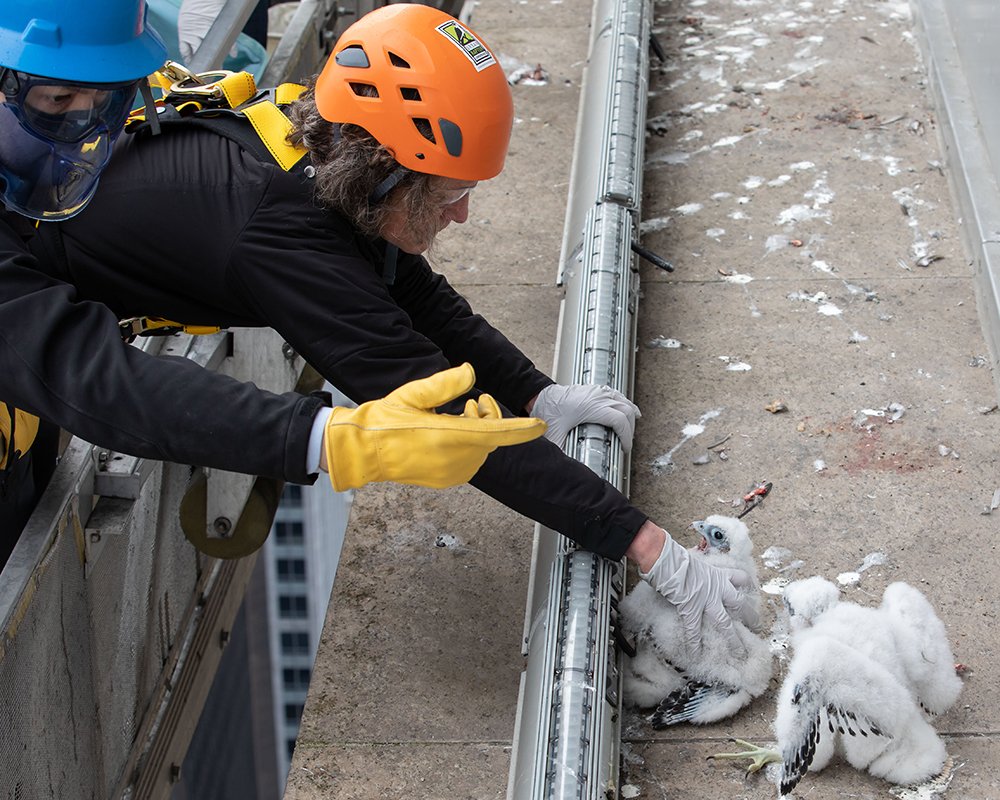
Collecting nestlings from their rooftop eyrie for banding (Jim Riley)
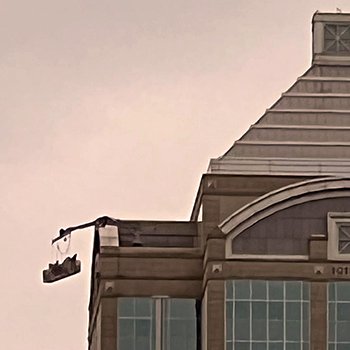
Hanging out at 1201 (Denis Tuzinovic)
1201 3rd Ave fledged four. We banded the nestlings in late May. Although downtown fledglings often quickly become window-hit casualties, only one was picked up for misdemeanor failure to stop at a window. He recovered quickly at PAWS Wildlife Center and was released from his 55th-floor rooftop, immediately attended to by his very protective mother. All four fledglings are still out there, or as we say, not known dead.
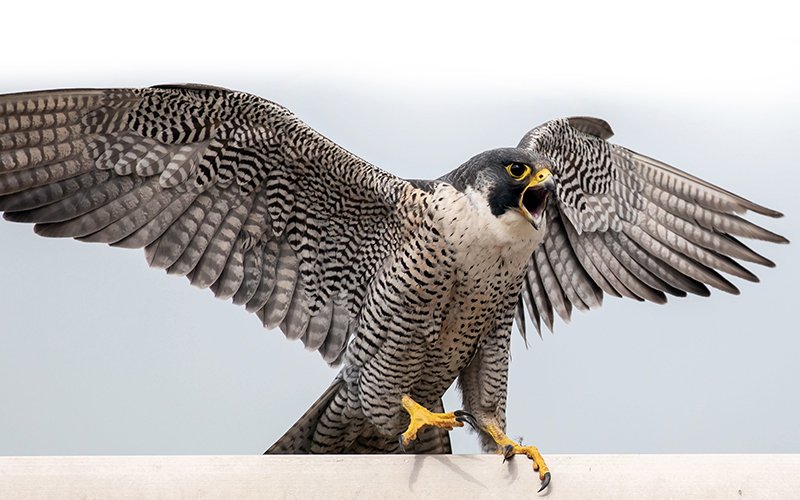
Mama peregrine objects to banding day at 1201 3rd Ave (Jim Riley)
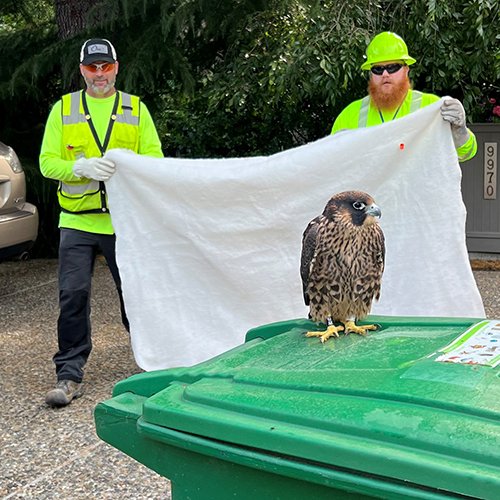
Fledgling 61-AK was rescued from the road in July by the Mercer Island Right of Way crew (Deeqa Roble)
East Channel Bridge fledged three, but let’s briefly back up: last winter the resident pair was joined by a juvenile, possibly their offspring from 2021. That’s a new one. Junior disappeared when nesting began. The nest was difficult to identify until we located begging calls by two nestlings, and finally three young peregrines appeared at the nest entrance. The first to launch flew well for two days, but on the third day the water won: he was found drowned near the Mercer Island Boat Launch by Peter Carr. Early in the morning of June 17, Jenn Kovach watched #2 leave the nest. This youngster also flew well, but then she ran out of gas, hit the water, and began swimming to Seattle. Jenn caught up with her by kayak and picked up her first peregrine. Off to PAWS. This fledgling, banded 61-AK, weighed over 1 kg, enormous for a peregrine. She was released a week later to join her surviving brother, who had successfully fledged on his own. We last saw him dogfighting crows and herons and learning slick prey-hunting moves from his parents. On July 5, 61-AK was found near the road by the Mercer Island R ight of Way crew, who protected her from traffic until she was able to fly off. We thank the crew and peregrine guardian Officer Anna Ormsby of Mercer Island Police.
West Seattle Bridge fledged three. The 2022 season was a tragedy for the West Seattle peregrines. First, some history. The resident adults, both banded, have nested there for five seasons, since 2018. The male (38-N) hatched in downtown Tacoma in 2016. The female (28-V) came from a nest on a crane in the Port of Olympia in 2013. She succeeded her sister at the West Seattle Bridge.
At first the peregrines seemed to benefit from the notorious two-year closure of the West Seattle Bridge. Their nesting season began peacefully, with the bridge repair delayed by the concrete workers’ strike. Peregrine watchers hoped that the strike would continue to favor the nesting season, but that was not to be: the strike ended and work resumed just as the female began laying. A large construction platform suddenly appeared right next to the nest site. Chaos ensued, but the adults did not abandon the nest.
Weeks later, Jim Riley found three young peregrines at the nest ready to fledge. Soon after, Jim found a fledgling walking on the ground, considering ending its short life on nearby West Marginal Way. Jim barehanded his first peregrine and placed it safely inside a construction fence. The kid promptly emerged from a gap in the fence, determined to walk to its death.
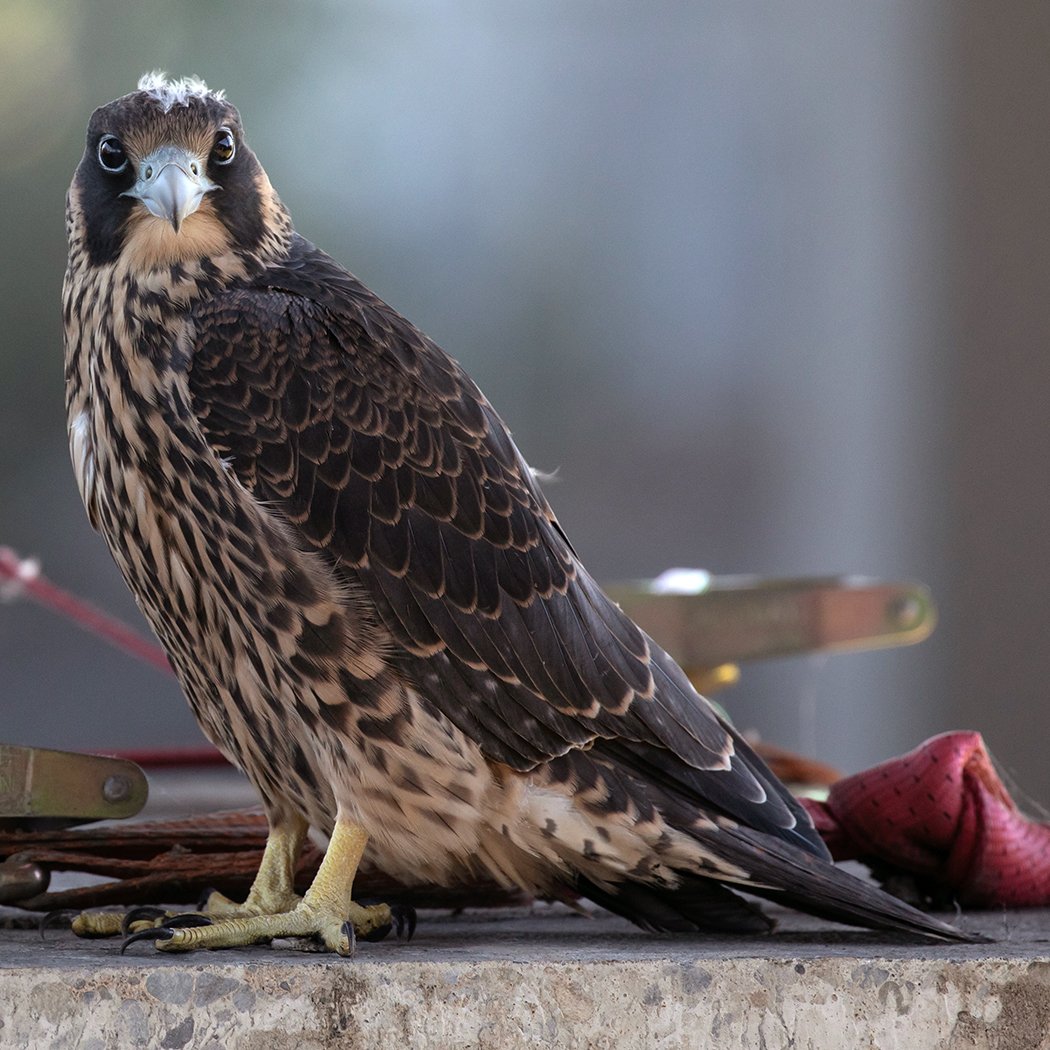
West Seattle Bridge fledgling #1 right after his rescue (Jim Riley)
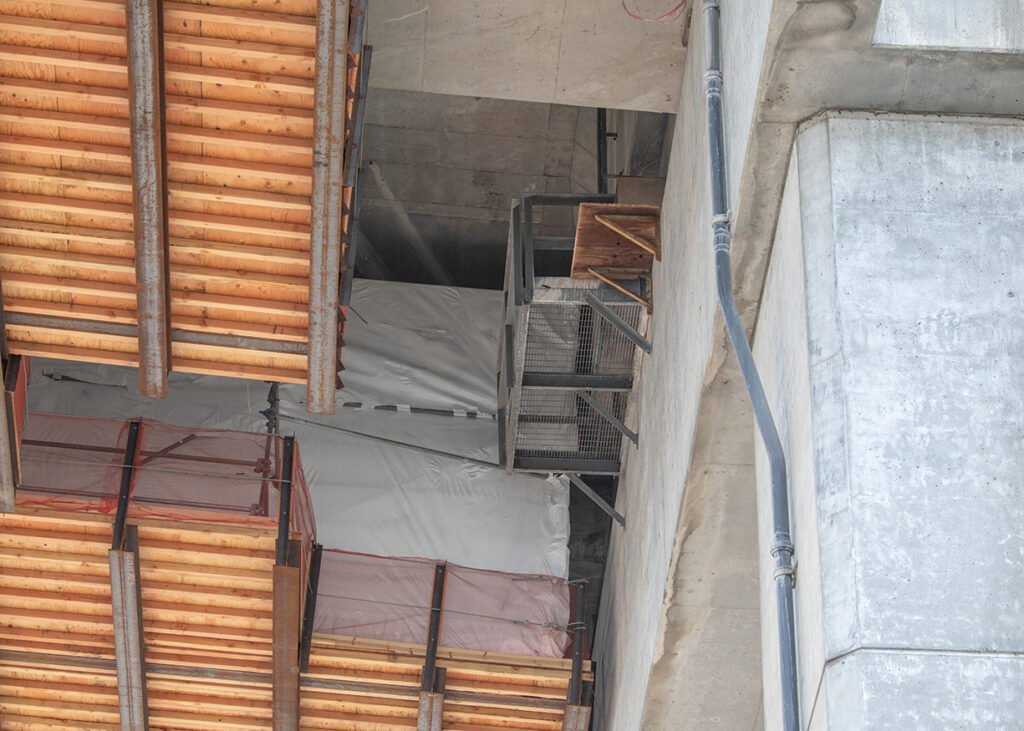
(L) Seattle Department of Transportation construction platform; (R) West Seattle peregrine nest box (Jim Riley)
Many texts later, Jeff Brown (PAWS) and Ed Deal arrived, put the fledgling in a box, and relieved Jim of his vigil. By this time, only one youngster was still at the nest, meaning that one was missing. Where to look? That answer was provided by Mom 28-V, perched nearby. Ed walked in the direction of her gaze—and found fledgling #2 trapped in a window well. Both fledglings went to PAWS for flying lessons and were later banded and released. The third youngster at the nest was not seen again.
Then things got worse. In early September, Dad 38-N, six years old and a father for four years, was picked up in West Seattle on Harbor Avenue, weak and possibly injured. He was taken to PAWS and died of avian flu (Highly Pathogenic Avian Influenza, HPAI). A week later Elaine Chuang learned of a dead adult peregrine, banded, in industrial downtown Seattle. To our knowledge, that peregrine has not been found nor its band 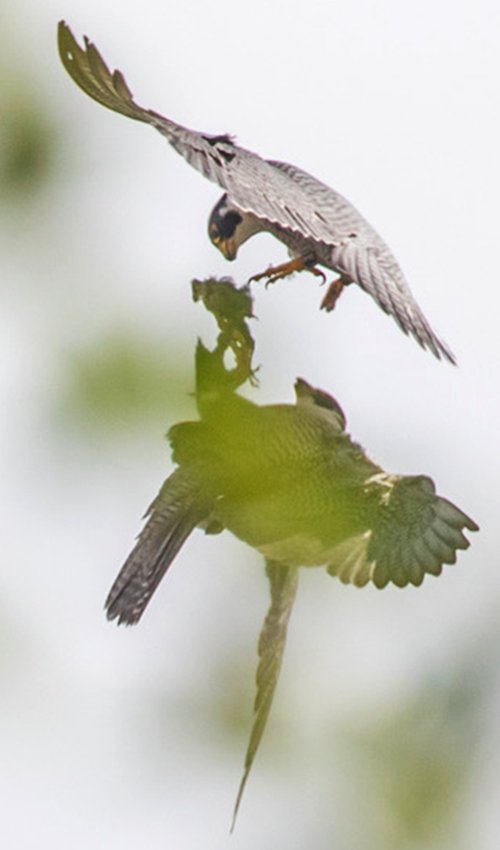 reported to the federal bird banding lab. Few adult peregrines in Seattle besides 28-V are banded. We are not optimistic about 28-V’s fate. An unbanded adult pair was seen courting at the West Seattle Bridge by Martin Muller In early October and by Kanit Cottrell and Patti Loesche in late November.
reported to the federal bird banding lab. Few adult peregrines in Seattle besides 28-V are banded. We are not optimistic about 28-V’s fate. An unbanded adult pair was seen courting at the West Seattle Bridge by Martin Muller In early October and by Kanit Cottrell and Patti Loesche in late November.
From 2018 to 2022, male 38-N and female 28-V reared 16 young. Of these, URC banded seven rescued fledglings (including this year’s). One, class of 2020, later died from a window strike in downtown Vancouver, BC.
The West Seattle peregrine pair, male 38-N and female 28-V, transferring prey (Jim Riley)
The new nest on the AGC building on South Lake Union fledged four. An adult male and second-year (immature) female were first seen at South Lake Union (SLU) in winter 2020-2021, favoring the 10-story AGC building. They defined a territory, not without skirmishes, between two existing peregrine sites (downtown and the grain terminal).
The AGC administration allowed URC to place a nest box on the balcony of the top floor, and the falcons accepted their new lodgings in 2022. The now-mature female and her mate enjoyed marvelous hospitality from GMMB, the inside tenants on the 10th floor. In deference to their peregrine overlords, GMMB darkened the windows and relinquished their water-facing Lake Union view to accommodate the nesting pair. Because the nest was hidden from outside view, we relied on GMMB tenants for news of the nestlings’ development.
In early June, we banded the four nestlings, all females. Then we awaited fledging. As we know, urban peregrines that fledge over water are often at high risk of drowning. Patti hastily formed a small but dedicated URC peregrine navy, with daily vigils before the anticipated fledge date of June 23. Jenn Kovach was on the water at dawn and dusk. In the hot middle of the day, Mel Fawcett-Routh was often on the water for five hours at a time. Everyone else showed up whenever asked and often stayed far longer than expected. Those long hours spent blind to the youngsters napping behind the balcony, were rewarded by memorable views of silly young peregrines and parental prey deliveries. Thank you, Jenn, Mel, Molly, Matt, Denis, Dave, Gail, Alex, and Michelle. These people are insane and proud of it.
We all had a lot of time to get to know each other, because the youngsters didn’t leave their balcony until a week after their expected fledge date. As that time approached, they were fed far less often. The hardest part of our vigil was enduring those endless heartbreaking wails. Tough love.
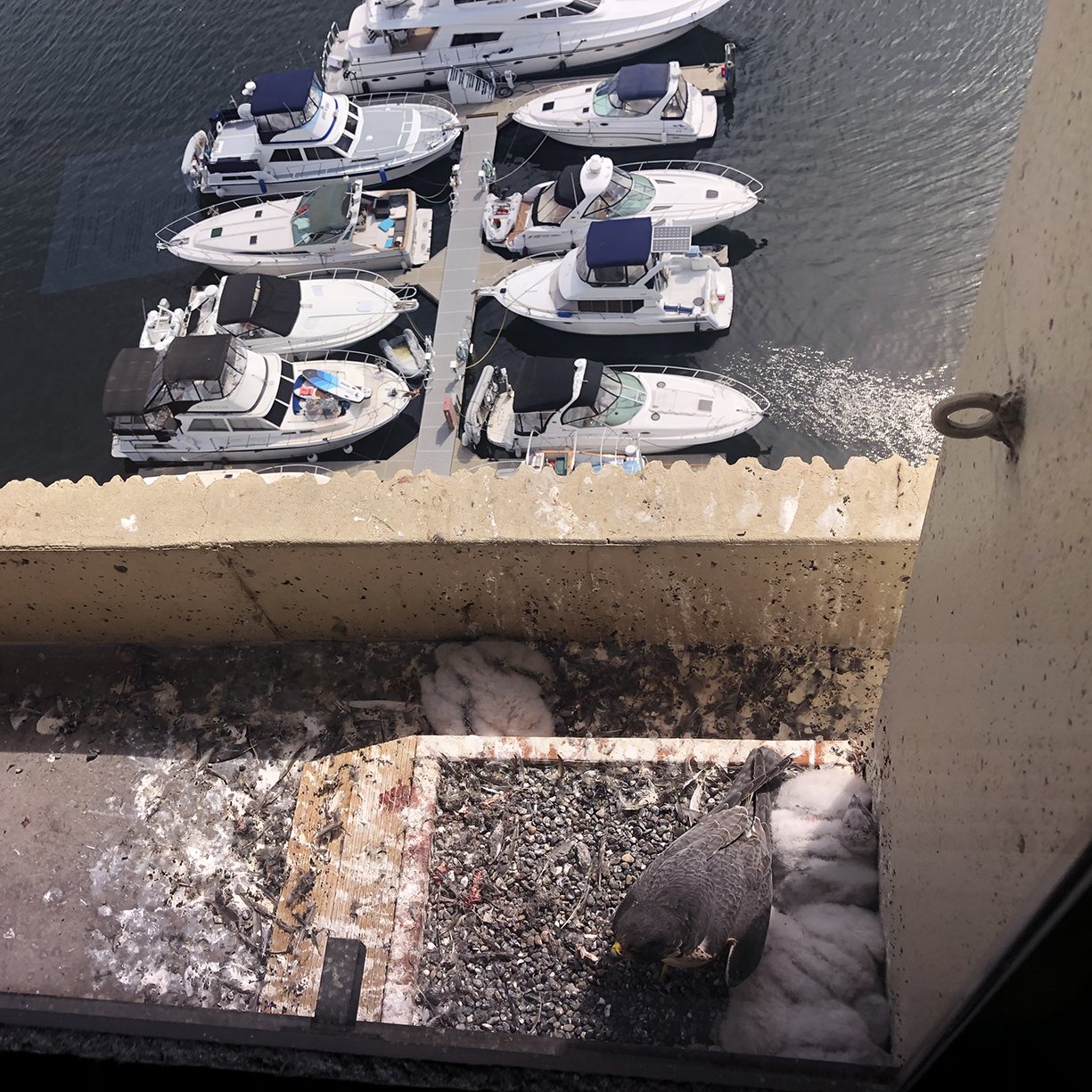
Balcony nest box at AGC (Anne Hilton)
44-AK was the first to go, but instead of fledging, she tumbled to the balconies below, and her mother stopped feeding her. After almost three days unfed, we engineered a rescue from her fifth-floor balcony. Sadly, 44-AK just could not fly and died in care at PAWS, but she was saved from a worse death from starvation. Sisters #2, 3, and 4 were well served by those extra days they took to fledge, and they didn’t need our vigilance. Every day since hatching, they watched their mom circle in to the balcony to feed them, then circle up to the roof. When it came their time to fly, each one also circled and flew up to the safety of the flat roof, just like mom. All three were soon bouncing around far from the nest between South Lake Union and Belltown. Our weary navy went back to our ordinary lives.
In late July, 43-AK was safely escorted from entrapment in a hot, glassed-in condo balcony. In October, 45-AK was found injured eight miles north of her nest and taken to PAWS. She had a shattered fracture, probably from a car, and she didn’t make it. Two sisters, 42-AK and 43-AK, are still out there.
This is the first time that peregrines have nested outside of office windows in Seattle (the 1201 peregrines enjoy a private penthouse). This new site was a brilliant success, thanks to our AGC hosts—especially Greg Crisostomo, Greg Manoske, and the GMMB stewards on the 10th floor. If the adults survive the winter, they’ll be back.
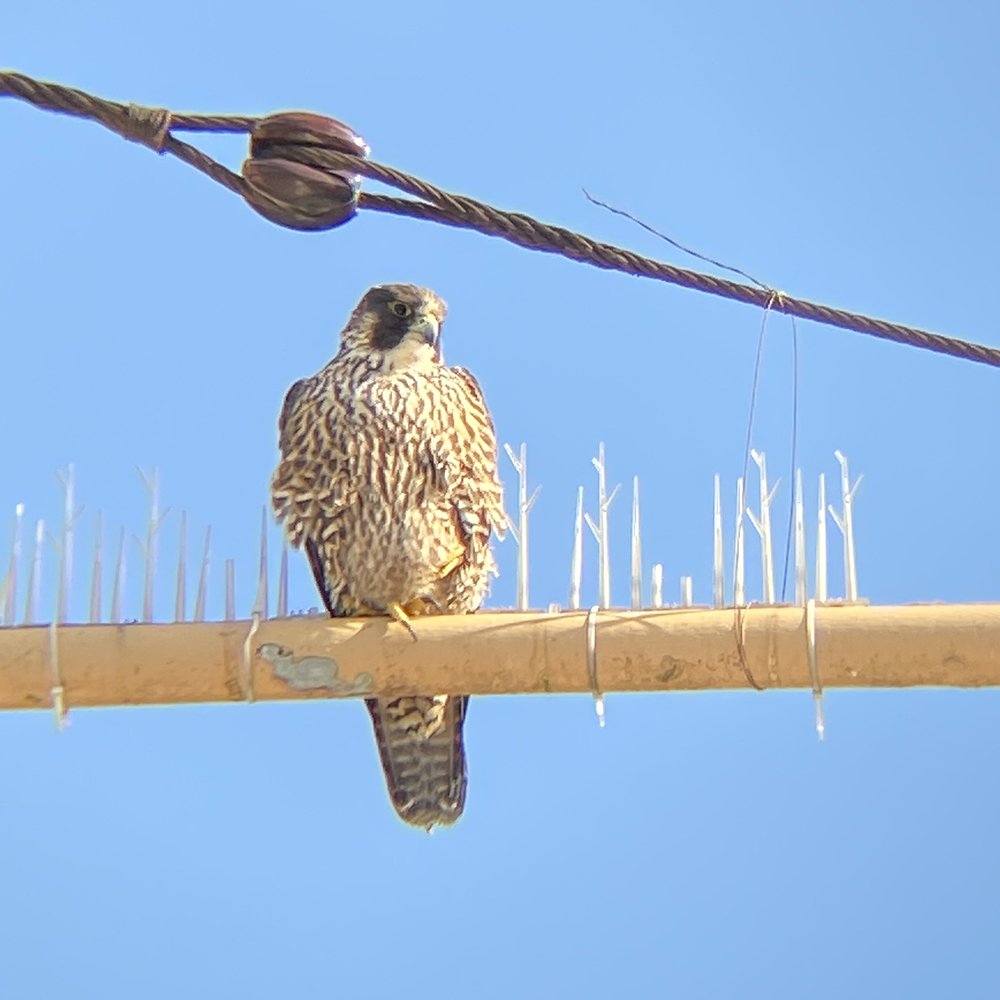
South Lake Union female in second-year plumage in 2021 on the lightship Swiftsure (Denis Tuzinovic)
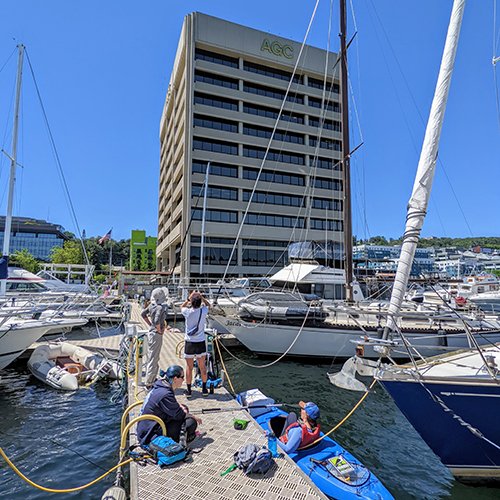
Peregrine navy at the AGC building (Matt Cryan)
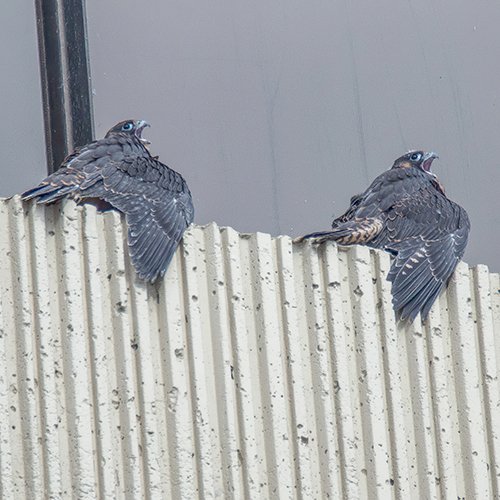
Begging AGC youngsters before fledging (Molly Cvetovac)
Roger Orness followed the two Tacoma sites. The nest on State Road 509 hatched two on May 28, with brooding of young confirmed on June 8. But the next day, both eyasses were gone and the eyrie abandoned. Predation? At Exit 132B, the pair chose a new eyrie this year. Hatch was around May 16, and three fledged on July 5.
Alas, the palatial nestbox in downtown Tacoma, home of longtime residents Murray and the fierce Harriet, was removed over the winter by the building owner. The new whereabouts of this historic pair are unknown. Individual adults were sporadically seen near the former nest site, but no nesting was confirmed. Roger often saw adults a mile north at the grain terminal, once stashing prey.
Roger, often with Peter Anderson, also headed to the Western Cascade foothills to observe peregrines nesting where they belong, at wild sites at Snoqualmie Falls, Rattlesnake Lake, and Deception Crags at Olallie State Park.
Snoqualmie Falls is monitored by Puget Sound Energy, but no peregrine activity was reported by their personnel, and no adults were observed on several visits. Rattlesnake Lake fledged three. The Olallie hatch was on May 17, and three fledged on June 27. The last nesting pair at Olallie was in 2012, 10 years ago. We are grateful to the area rock climbers who respected the temporary closure of a few climbing routes during the nesting season.
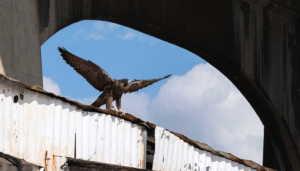
A-78 at University Bridge (Spike Mafford)
Female A-78 fledged in 2019 from University Bridge in Seattle. She almost drowned twice as a fledgling, pretty harrowing even for a peregrine. In April —almost three years later—she was picked up in Vancouver, BC, with minor injuries and spent six days in rehab. She had an egg inside of her: she was nesting! When released from the site where she was found, she took off into the distance and has yet to be seen since. Wonder where her nest was.
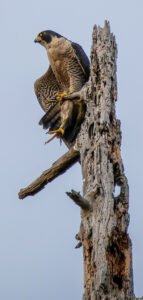 We were elated by three reports of banded peregrines who had dispersed from Seattle and Tacoma nests in previous years. They traveled far and were found alive and well.
We were elated by three reports of banded peregrines who had dispersed from Seattle and Tacoma nests in previous years. They traveled far and were found alive and well.
In February, Ed Dominguez of Seward Park Audubon sent us a photo of a male peregrine, 42-AD, fortuitously taken by Molly Cvetovac. This is the first known sighting of 42-AD since he left his downtown Tacoma nest in 2020.
42-AD in Seward Park (Molly Cvetovac)
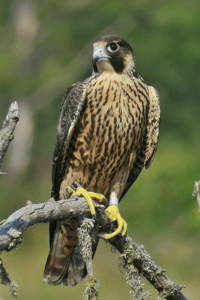 Female 88-AK (left), fledged from the East Channel Bridge in 2017 and was found nesting in Vancouver, BC. More on 88-AK in our upcoming annual report.
Female 88-AK (left), fledged from the East Channel Bridge in 2017 and was found nesting in Vancouver, BC. More on 88-AK in our upcoming annual report.
88-AK in Skagit County in 2017 (Mike Hamilton)